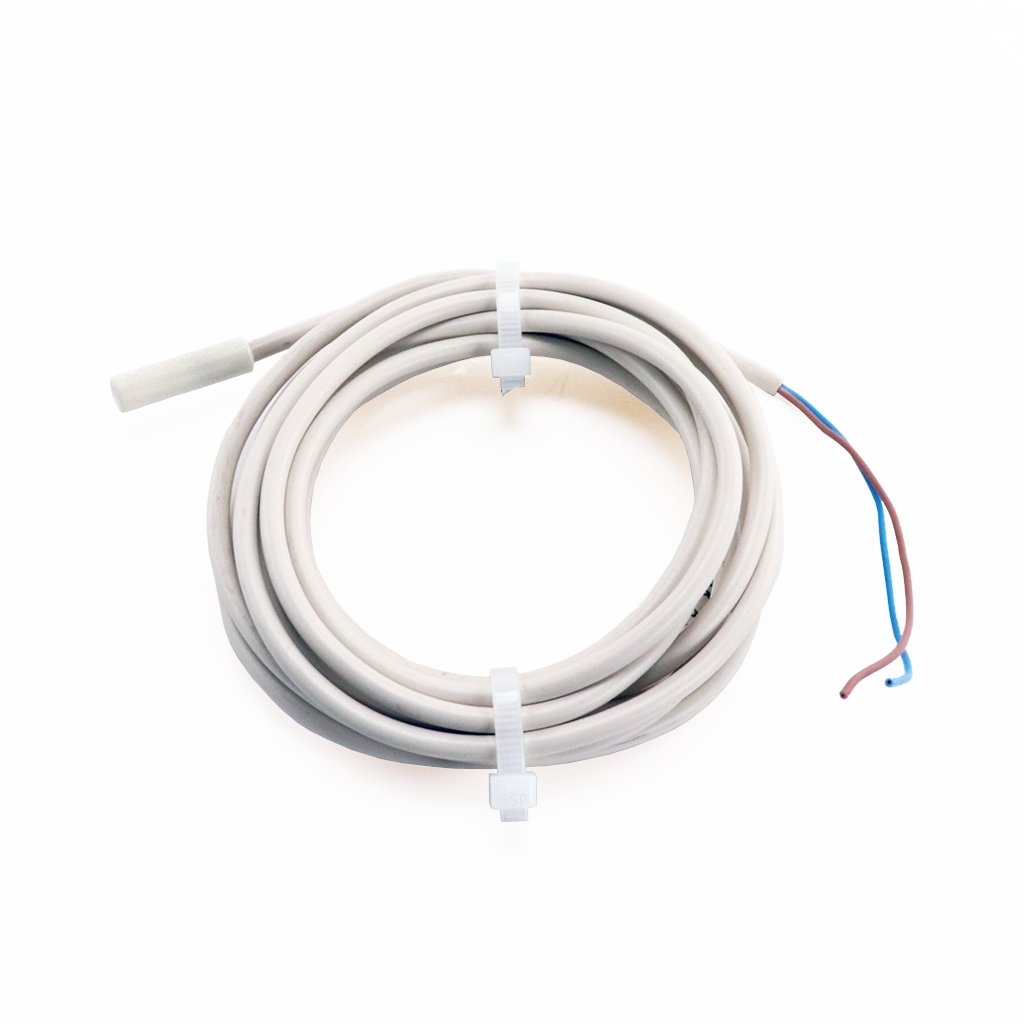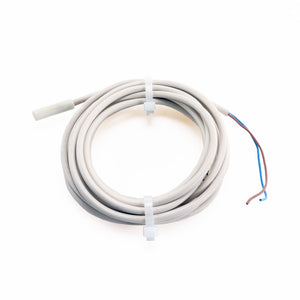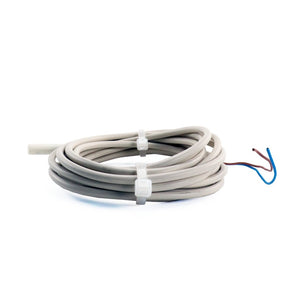
DSC PGTemp-Probe External Temperature Probe For PG9905 Sensor
The PGTemp-Probe from DSC is used with the PG9905 wireless temperature sensor. The DSC PG9905 PowerG 915MHZ Wireless Temperature Detector is designed for indoor use only and is not weatherproof or made for use in extreme temperatures.
The PGTemp-Probe will wire into the PG9905 and let you monitor temperatures in a freezer so that you can monitor if it is staying within the proper temperature range. This would be ideal for not only homes but for stores as well.
Another use for the PGTemp-Probe would be to monitor the outside temperature of a home or a business. Using this in conjunction with the DSC NEO one could use it to trigger the programmable outputs on the NEO to turn on an external device such as a heater. If you're using the NEO with Alarm.com Interactive Services w/ Home Automation support one could use this to raise or lower the temperature in the building by having a Z-Wave thermostat adjust when the temperature drops or rises to a certain temperature range.
The probe measures 11' long. The wire leads coming off of the probe are 6" and you can extend this by adding your own wire.
QUESTIONS & ANSWERS
Ask a Question-
Is there any difference which wire (brown or blue) you connect on either side of the connector block on the sensor? Do you have to do anything beside connecting the probe to the sensor to make it work? Also the sensor came with a small wire bridging both sides of the connector block. I'm guessing it has to be disposed of. Thanks in advance.
There is no polarity on the probe wires, so you may connect either wire to either terminal. The exisitng short wire is just a jumper wire to take the place of the probe when it is not being used, so it may be disposed of.
Related Products
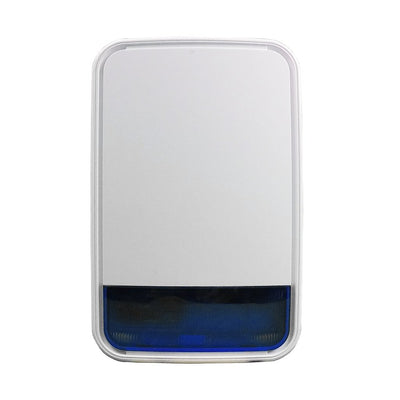
-
{"id":545251328044,"title":"DSC PG9911B-BATT Wireless Power G Outdoor Siren and Strobe (Includes Lithium Battery)","handle":"dsc-pg9911b-batt-wireless-power-g-outdoor-siren-and-strobe","description":"\u003cp class=\"product-excerpt\"\u003eThe perfect combination of a siren, strobe, and wireless technology, the PG9911B is a very effective outdoor wireless siren for the DSC NEO or Qolsys IQ Panels. Giving you 110db of sound output and a bright blue flashing strobe, anyone close by will know your home has been compromised and emergency services will have no problem locating the alarm.\u003c\/p\u003e\n\u003chr\u003e\n\u003ch2\u003eDSC PG9911B-BATT Wireless Power G Outdoor Siren and Strobe (Includes Lithium Battery)\u003c\/h2\u003e\n\u003cp\u003eThe DSC PG9911B-BATT Wireless PowerG Outdoor Siren and Strobe can be added to any DSC NEO alarm system that has either a keypad like the \u003ca title=\"DSC POWERSERIES NEO HS2LCDRF9ENG FULL MESSAGE LCD HARDWIRED KEYPAD W\/ ENGLISH FUNCTION KEYS AND BUILT-IN POWERG TRANSCEIVER\" href=\"https:\/\/www.alarmsystemstore.com\/products\/dsc-neo-hs2lcdrf9eng-keypad\"\u003eHS2LCDRF9ENG\u003c\/a\u003e with its built-in transceiver or by using the \u003ca title=\"DSC POWERSERIES HSM2HOST9 POWERG 915MHZ HOST TRANSCEIVER MODULE\" href=\"https:\/\/www.alarmsystemstore.com\/products\/dsc-powerseries-hsm2host9-powerg-915mhz-host-transceiver-module\"\u003eHSM2HOST9\u003c\/a\u003e transceiver. \u003c\/p\u003e\n\u003cp\u003eThe PG9911B-BATT includes the Lithium battery that powers it so you won't have to purchase this separately. The siren itself can produce a piercing alarm sound of 110 dB and has a built-in blue strobe light that will act as a visual alert to draw more attention. The siren is fully supervised which means that it can register tamper conditions in case an intruder tries to defeat it by removing it from its mounting position and it will send battery life status to the main alarm to let you know if you need to change out the battery or not.\u003c\/p\u003e\n\u003cp\u003eThe siren and strobe will make different noises and flashing patterns for burglary, fire, or medical conditions so that the exact nature of a problem can be ascertained by those who are outside of the home or business. The siren features multichannel, frequency hopping technology that helps to overcome blocking attempts and helps to deal with any sort of environmental electrical interference. The PG9911B-BATT has an impressive transmission range of up to 6,651 feet line-of-sight. This sign also features 128 bit AES encryption to make it hard for anyone to tamper with if they happen to try. \u003c\/p\u003e\n\u003cp\u003eThe siren measures 11.63 x 7.31 x 2.5 in. and the battery that comes with this has an 8-year life expectancy. This siren can take what the environment will dish out as far as weather goes because of its robust weatherproof housing. It has an Ingress Protection rating of IP5 and will stand up to dust and jets of water. \u003c\/p\u003e\n\u003cp\u003e\u003cspan style=\"font-weight: bold; font-size: 14pt;\"\u003eNOTE: \u003c\/span\u003e\u003cspan style=\"color: #ff0000; font-weight: bold; font-size: 12pt;\"\u003eThis item cannot be shipped via air and as such cannot be\u003cbr\u003eshipped outside of the lower 48 USA. These also cannot be shipped via expedited shipping. (2nd Day, Overnight, etc.)\u003c\/span\u003e\u003c\/p\u003e\n\u003ch2\u003eSpecifications:\u003c\/h2\u003e\n\u003cp\u003eDimensions:... 295 x 186 x 63mm (11.63 x 7.31 x 2.5 in.)\u003cbr\u003eBattery Life: ............................up to 8 years (typical use)\u003cbr\u003eBattery Type: ............3.6V, Li-Thionyl Chloride 0-102710\u003cbr\u003eWeight (including battery): ............................970g (34oz)\u003cbr\u003eOperating Temperature: ...........................-33°C to 70°C (-27.4°F to 158°F)\u003c\/p\u003e\n\u003cp\u003e\u003ca title=\"DSC PG9911 Installation manual\" href=\"https:\/\/cdn.shopify.com\/s\/files\/1\/1659\/9809\/files\/PG9911-8911-4911_Installation_Manual_ENG-FRE-SPA-POR-29008699R001_ac225ddd-1d38-4425-9205-6fb86dceaf7d.pdf?14014899548036957194\" target=\"_blank\"\u003eDSC PG9911 Installation manual\u003cbr\u003e\u003c\/a\u003e\u003ca title=\"DSC PG9911 Specifications sheet\" href=\"https:\/\/cdn.shopify.com\/s\/files\/1\/1659\/9809\/files\/30001552R001_PG9911_Spec_Eng_4da50321-16e6-4c83-a486-00421b43b8f2.pdf?14014899548036957194\" target=\"_blank\"\u003eDSC PG9911 Specifications sheet\u003c\/a\u003e\u003c\/p\u003e","published_at":"2018-02-14T17:05:49-05:00","created_at":"2018-02-14T13:35:31-05:00","vendor":"DSC","type":"DSC PowerSeries NEO Power G Wireless","tags":["9911","DSC PowerSeries NEO","DSC PowerSeries NEO Power G Wireless","DSC-PG9911BBATT","Els PW 22592","PG9911","PG9911BBATT"],"price":19495,"price_min":19495,"price_max":19495,"available":true,"price_varies":false,"compare_at_price":23099,"compare_at_price_min":23099,"compare_at_price_max":23099,"compare_at_price_varies":false,"variants":[{"id":7034153631788,"title":"Default Title","option1":"Default Title","option2":null,"option3":null,"sku":"DSC-PG9911BBATT","requires_shipping":true,"taxable":true,"featured_image":null,"available":true,"name":"DSC PG9911B-BATT Wireless Power G Outdoor Siren and Strobe (Includes Lithium Battery)","public_title":null,"options":["Default Title"],"price":19495,"weight":1361,"compare_at_price":23099,"inventory_quantity":2,"inventory_management":"shopify","inventory_policy":"continue","barcode":"DSC-PG9911BBATT","requires_selling_plan":false,"selling_plan_allocations":[]}],"images":["\/\/www.alarmsystemstore.com\/cdn\/shop\/products\/dsc-pg9911b-batt-wireless-power-g-outdoor-siren-and-strobe-includes-lithium-battery-233987.jpg?v=1595526128","\/\/www.alarmsystemstore.com\/cdn\/shop\/products\/dsc-pg9911b-batt-wireless-power-g-outdoor-siren-and-strobe-includes-lithium-battery-256155.jpg?v=1595526128"],"featured_image":"\/\/www.alarmsystemstore.com\/cdn\/shop\/products\/dsc-pg9911b-batt-wireless-power-g-outdoor-siren-and-strobe-includes-lithium-battery-233987.jpg?v=1595526128","options":["Title"],"media":[{"alt":"DSC PG9911B-BATT Wireless Power G Outdoor Siren and Strobe (Includes Lithium Battery) - AlarmSystemStore.com","id":7363122298982,"position":1,"preview_image":{"aspect_ratio":1.0,"height":1024,"width":1024,"src":"\/\/www.alarmsystemstore.com\/cdn\/shop\/products\/dsc-pg9911b-batt-wireless-power-g-outdoor-siren-and-strobe-includes-lithium-battery-233987.jpg?v=1595526128"},"aspect_ratio":1.0,"height":1024,"media_type":"image","src":"\/\/www.alarmsystemstore.com\/cdn\/shop\/products\/dsc-pg9911b-batt-wireless-power-g-outdoor-siren-and-strobe-includes-lithium-battery-233987.jpg?v=1595526128","width":1024},{"alt":"DSC PG9911B-BATT Wireless Power G Outdoor Siren and Strobe (Includes Lithium Battery) - AlarmSystemStore.com","id":7363122331750,"position":2,"preview_image":{"aspect_ratio":1.0,"height":1024,"width":1024,"src":"\/\/www.alarmsystemstore.com\/cdn\/shop\/products\/dsc-pg9911b-batt-wireless-power-g-outdoor-siren-and-strobe-includes-lithium-battery-256155.jpg?v=1595526128"},"aspect_ratio":1.0,"height":1024,"media_type":"image","src":"\/\/www.alarmsystemstore.com\/cdn\/shop\/products\/dsc-pg9911b-batt-wireless-power-g-outdoor-siren-and-strobe-includes-lithium-battery-256155.jpg?v=1595526128","width":1024}],"requires_selling_plan":false,"selling_plan_groups":[],"content":"\u003cp class=\"product-excerpt\"\u003eThe perfect combination of a siren, strobe, and wireless technology, the PG9911B is a very effective outdoor wireless siren for the DSC NEO or Qolsys IQ Panels. Giving you 110db of sound output and a bright blue flashing strobe, anyone close by will know your home has been compromised and emergency services will have no problem locating the alarm.\u003c\/p\u003e\n\u003chr\u003e\n\u003ch2\u003eDSC PG9911B-BATT Wireless Power G Outdoor Siren and Strobe (Includes Lithium Battery)\u003c\/h2\u003e\n\u003cp\u003eThe DSC PG9911B-BATT Wireless PowerG Outdoor Siren and Strobe can be added to any DSC NEO alarm system that has either a keypad like the \u003ca title=\"DSC POWERSERIES NEO HS2LCDRF9ENG FULL MESSAGE LCD HARDWIRED KEYPAD W\/ ENGLISH FUNCTION KEYS AND BUILT-IN POWERG TRANSCEIVER\" href=\"https:\/\/www.alarmsystemstore.com\/products\/dsc-neo-hs2lcdrf9eng-keypad\"\u003eHS2LCDRF9ENG\u003c\/a\u003e with its built-in transceiver or by using the \u003ca title=\"DSC POWERSERIES HSM2HOST9 POWERG 915MHZ HOST TRANSCEIVER MODULE\" href=\"https:\/\/www.alarmsystemstore.com\/products\/dsc-powerseries-hsm2host9-powerg-915mhz-host-transceiver-module\"\u003eHSM2HOST9\u003c\/a\u003e transceiver. \u003c\/p\u003e\n\u003cp\u003eThe PG9911B-BATT includes the Lithium battery that powers it so you won't have to purchase this separately. The siren itself can produce a piercing alarm sound of 110 dB and has a built-in blue strobe light that will act as a visual alert to draw more attention. The siren is fully supervised which means that it can register tamper conditions in case an intruder tries to defeat it by removing it from its mounting position and it will send battery life status to the main alarm to let you know if you need to change out the battery or not.\u003c\/p\u003e\n\u003cp\u003eThe siren and strobe will make different noises and flashing patterns for burglary, fire, or medical conditions so that the exact nature of a problem can be ascertained by those who are outside of the home or business. The siren features multichannel, frequency hopping technology that helps to overcome blocking attempts and helps to deal with any sort of environmental electrical interference. The PG9911B-BATT has an impressive transmission range of up to 6,651 feet line-of-sight. This sign also features 128 bit AES encryption to make it hard for anyone to tamper with if they happen to try. \u003c\/p\u003e\n\u003cp\u003eThe siren measures 11.63 x 7.31 x 2.5 in. and the battery that comes with this has an 8-year life expectancy. This siren can take what the environment will dish out as far as weather goes because of its robust weatherproof housing. It has an Ingress Protection rating of IP5 and will stand up to dust and jets of water. \u003c\/p\u003e\n\u003cp\u003e\u003cspan style=\"font-weight: bold; font-size: 14pt;\"\u003eNOTE: \u003c\/span\u003e\u003cspan style=\"color: #ff0000; font-weight: bold; font-size: 12pt;\"\u003eThis item cannot be shipped via air and as such cannot be\u003cbr\u003eshipped outside of the lower 48 USA. These also cannot be shipped via expedited shipping. (2nd Day, Overnight, etc.)\u003c\/span\u003e\u003c\/p\u003e\n\u003ch2\u003eSpecifications:\u003c\/h2\u003e\n\u003cp\u003eDimensions:... 295 x 186 x 63mm (11.63 x 7.31 x 2.5 in.)\u003cbr\u003eBattery Life: ............................up to 8 years (typical use)\u003cbr\u003eBattery Type: ............3.6V, Li-Thionyl Chloride 0-102710\u003cbr\u003eWeight (including battery): ............................970g (34oz)\u003cbr\u003eOperating Temperature: ...........................-33°C to 70°C (-27.4°F to 158°F)\u003c\/p\u003e\n\u003cp\u003e\u003ca title=\"DSC PG9911 Installation manual\" href=\"https:\/\/cdn.shopify.com\/s\/files\/1\/1659\/9809\/files\/PG9911-8911-4911_Installation_Manual_ENG-FRE-SPA-POR-29008699R001_ac225ddd-1d38-4425-9205-6fb86dceaf7d.pdf?14014899548036957194\" target=\"_blank\"\u003eDSC PG9911 Installation manual\u003cbr\u003e\u003c\/a\u003e\u003ca title=\"DSC PG9911 Specifications sheet\" href=\"https:\/\/cdn.shopify.com\/s\/files\/1\/1659\/9809\/files\/30001552R001_PG9911_Spec_Eng_4da50321-16e6-4c83-a486-00421b43b8f2.pdf?14014899548036957194\" target=\"_blank\"\u003eDSC PG9911 Specifications sheet\u003c\/a\u003e\u003c\/p\u003e"}
-
{"id":545251328044,"title":"DSC PG9911B-BATT Wireless Power G Outdoor Siren and Strobe (Includes Lithium Battery)","handle":"dsc-pg9911b-batt-wireless-power-g-outdoor-siren-and-strobe","description":"\u003cp class=\"product-excerpt\"\u003eThe perfect combination of a siren, strobe, and wireless technology, the PG9911B is a very effective outdoor wireless siren for the DSC NEO or Qolsys IQ Panels. Giving you 110db of sound output and a bright blue flashing strobe, anyone close by will know your home has been compromised and emergency services will have no problem locating the alarm.\u003c\/p\u003e\n\u003chr\u003e\n\u003ch2\u003eDSC PG9911B-BATT Wireless Power G Outdoor Siren and Strobe (Includes Lithium Battery)\u003c\/h2\u003e\n\u003cp\u003eThe DSC PG9911B-BATT Wireless PowerG Outdoor Siren and Strobe can be added to any DSC NEO alarm system that has either a keypad like the \u003ca title=\"DSC POWERSERIES NEO HS2LCDRF9ENG FULL MESSAGE LCD HARDWIRED KEYPAD W\/ ENGLISH FUNCTION KEYS AND BUILT-IN POWERG TRANSCEIVER\" href=\"https:\/\/www.alarmsystemstore.com\/products\/dsc-neo-hs2lcdrf9eng-keypad\"\u003eHS2LCDRF9ENG\u003c\/a\u003e with its built-in transceiver or by using the \u003ca title=\"DSC POWERSERIES HSM2HOST9 POWERG 915MHZ HOST TRANSCEIVER MODULE\" href=\"https:\/\/www.alarmsystemstore.com\/products\/dsc-powerseries-hsm2host9-powerg-915mhz-host-transceiver-module\"\u003eHSM2HOST9\u003c\/a\u003e transceiver. \u003c\/p\u003e\n\u003cp\u003eThe PG9911B-BATT includes the Lithium battery that powers it so you won't have to purchase this separately. The siren itself can produce a piercing alarm sound of 110 dB and has a built-in blue strobe light that will act as a visual alert to draw more attention. The siren is fully supervised which means that it can register tamper conditions in case an intruder tries to defeat it by removing it from its mounting position and it will send battery life status to the main alarm to let you know if you need to change out the battery or not.\u003c\/p\u003e\n\u003cp\u003eThe siren and strobe will make different noises and flashing patterns for burglary, fire, or medical conditions so that the exact nature of a problem can be ascertained by those who are outside of the home or business. The siren features multichannel, frequency hopping technology that helps to overcome blocking attempts and helps to deal with any sort of environmental electrical interference. The PG9911B-BATT has an impressive transmission range of up to 6,651 feet line-of-sight. This sign also features 128 bit AES encryption to make it hard for anyone to tamper with if they happen to try. \u003c\/p\u003e\n\u003cp\u003eThe siren measures 11.63 x 7.31 x 2.5 in. and the battery that comes with this has an 8-year life expectancy. This siren can take what the environment will dish out as far as weather goes because of its robust weatherproof housing. It has an Ingress Protection rating of IP5 and will stand up to dust and jets of water. \u003c\/p\u003e\n\u003cp\u003e\u003cspan style=\"font-weight: bold; font-size: 14pt;\"\u003eNOTE: \u003c\/span\u003e\u003cspan style=\"color: #ff0000; font-weight: bold; font-size: 12pt;\"\u003eThis item cannot be shipped via air and as such cannot be\u003cbr\u003eshipped outside of the lower 48 USA. These also cannot be shipped via expedited shipping. (2nd Day, Overnight, etc.)\u003c\/span\u003e\u003c\/p\u003e\n\u003ch2\u003eSpecifications:\u003c\/h2\u003e\n\u003cp\u003eDimensions:... 295 x 186 x 63mm (11.63 x 7.31 x 2.5 in.)\u003cbr\u003eBattery Life: ............................up to 8 years (typical use)\u003cbr\u003eBattery Type: ............3.6V, Li-Thionyl Chloride 0-102710\u003cbr\u003eWeight (including battery): ............................970g (34oz)\u003cbr\u003eOperating Temperature: ...........................-33°C to 70°C (-27.4°F to 158°F)\u003c\/p\u003e\n\u003cp\u003e\u003ca title=\"DSC PG9911 Installation manual\" href=\"https:\/\/cdn.shopify.com\/s\/files\/1\/1659\/9809\/files\/PG9911-8911-4911_Installation_Manual_ENG-FRE-SPA-POR-29008699R001_ac225ddd-1d38-4425-9205-6fb86dceaf7d.pdf?14014899548036957194\" target=\"_blank\"\u003eDSC PG9911 Installation manual\u003cbr\u003e\u003c\/a\u003e\u003ca title=\"DSC PG9911 Specifications sheet\" href=\"https:\/\/cdn.shopify.com\/s\/files\/1\/1659\/9809\/files\/30001552R001_PG9911_Spec_Eng_4da50321-16e6-4c83-a486-00421b43b8f2.pdf?14014899548036957194\" target=\"_blank\"\u003eDSC PG9911 Specifications sheet\u003c\/a\u003e\u003c\/p\u003e","published_at":"2018-02-14T17:05:49-05:00","created_at":"2018-02-14T13:35:31-05:00","vendor":"DSC","type":"DSC PowerSeries NEO Power G Wireless","tags":["9911","DSC PowerSeries NEO","DSC PowerSeries NEO Power G Wireless","DSC-PG9911BBATT","Els PW 22592","PG9911","PG9911BBATT"],"price":19495,"price_min":19495,"price_max":19495,"available":true,"price_varies":false,"compare_at_price":23099,"compare_at_price_min":23099,"compare_at_price_max":23099,"compare_at_price_varies":false,"variants":[{"id":7034153631788,"title":"Default Title","option1":"Default Title","option2":null,"option3":null,"sku":"DSC-PG9911BBATT","requires_shipping":true,"taxable":true,"featured_image":null,"available":true,"name":"DSC PG9911B-BATT Wireless Power G Outdoor Siren and Strobe (Includes Lithium Battery)","public_title":null,"options":["Default Title"],"price":19495,"weight":1361,"compare_at_price":23099,"inventory_quantity":2,"inventory_management":"shopify","inventory_policy":"continue","barcode":"DSC-PG9911BBATT","requires_selling_plan":false,"selling_plan_allocations":[]}],"images":["\/\/www.alarmsystemstore.com\/cdn\/shop\/products\/dsc-pg9911b-batt-wireless-power-g-outdoor-siren-and-strobe-includes-lithium-battery-233987.jpg?v=1595526128","\/\/www.alarmsystemstore.com\/cdn\/shop\/products\/dsc-pg9911b-batt-wireless-power-g-outdoor-siren-and-strobe-includes-lithium-battery-256155.jpg?v=1595526128"],"featured_image":"\/\/www.alarmsystemstore.com\/cdn\/shop\/products\/dsc-pg9911b-batt-wireless-power-g-outdoor-siren-and-strobe-includes-lithium-battery-233987.jpg?v=1595526128","options":["Title"],"media":[{"alt":"DSC PG9911B-BATT Wireless Power G Outdoor Siren and Strobe (Includes Lithium Battery) - AlarmSystemStore.com","id":7363122298982,"position":1,"preview_image":{"aspect_ratio":1.0,"height":1024,"width":1024,"src":"\/\/www.alarmsystemstore.com\/cdn\/shop\/products\/dsc-pg9911b-batt-wireless-power-g-outdoor-siren-and-strobe-includes-lithium-battery-233987.jpg?v=1595526128"},"aspect_ratio":1.0,"height":1024,"media_type":"image","src":"\/\/www.alarmsystemstore.com\/cdn\/shop\/products\/dsc-pg9911b-batt-wireless-power-g-outdoor-siren-and-strobe-includes-lithium-battery-233987.jpg?v=1595526128","width":1024},{"alt":"DSC PG9911B-BATT Wireless Power G Outdoor Siren and Strobe (Includes Lithium Battery) - AlarmSystemStore.com","id":7363122331750,"position":2,"preview_image":{"aspect_ratio":1.0,"height":1024,"width":1024,"src":"\/\/www.alarmsystemstore.com\/cdn\/shop\/products\/dsc-pg9911b-batt-wireless-power-g-outdoor-siren-and-strobe-includes-lithium-battery-256155.jpg?v=1595526128"},"aspect_ratio":1.0,"height":1024,"media_type":"image","src":"\/\/www.alarmsystemstore.com\/cdn\/shop\/products\/dsc-pg9911b-batt-wireless-power-g-outdoor-siren-and-strobe-includes-lithium-battery-256155.jpg?v=1595526128","width":1024}],"requires_selling_plan":false,"selling_plan_groups":[],"content":"\u003cp class=\"product-excerpt\"\u003eThe perfect combination of a siren, strobe, and wireless technology, the PG9911B is a very effective outdoor wireless siren for the DSC NEO or Qolsys IQ Panels. Giving you 110db of sound output and a bright blue flashing strobe, anyone close by will know your home has been compromised and emergency services will have no problem locating the alarm.\u003c\/p\u003e\n\u003chr\u003e\n\u003ch2\u003eDSC PG9911B-BATT Wireless Power G Outdoor Siren and Strobe (Includes Lithium Battery)\u003c\/h2\u003e\n\u003cp\u003eThe DSC PG9911B-BATT Wireless PowerG Outdoor Siren and Strobe can be added to any DSC NEO alarm system that has either a keypad like the \u003ca title=\"DSC POWERSERIES NEO HS2LCDRF9ENG FULL MESSAGE LCD HARDWIRED KEYPAD W\/ ENGLISH FUNCTION KEYS AND BUILT-IN POWERG TRANSCEIVER\" href=\"https:\/\/www.alarmsystemstore.com\/products\/dsc-neo-hs2lcdrf9eng-keypad\"\u003eHS2LCDRF9ENG\u003c\/a\u003e with its built-in transceiver or by using the \u003ca title=\"DSC POWERSERIES HSM2HOST9 POWERG 915MHZ HOST TRANSCEIVER MODULE\" href=\"https:\/\/www.alarmsystemstore.com\/products\/dsc-powerseries-hsm2host9-powerg-915mhz-host-transceiver-module\"\u003eHSM2HOST9\u003c\/a\u003e transceiver. \u003c\/p\u003e\n\u003cp\u003eThe PG9911B-BATT includes the Lithium battery that powers it so you won't have to purchase this separately. The siren itself can produce a piercing alarm sound of 110 dB and has a built-in blue strobe light that will act as a visual alert to draw more attention. The siren is fully supervised which means that it can register tamper conditions in case an intruder tries to defeat it by removing it from its mounting position and it will send battery life status to the main alarm to let you know if you need to change out the battery or not.\u003c\/p\u003e\n\u003cp\u003eThe siren and strobe will make different noises and flashing patterns for burglary, fire, or medical conditions so that the exact nature of a problem can be ascertained by those who are outside of the home or business. The siren features multichannel, frequency hopping technology that helps to overcome blocking attempts and helps to deal with any sort of environmental electrical interference. The PG9911B-BATT has an impressive transmission range of up to 6,651 feet line-of-sight. This sign also features 128 bit AES encryption to make it hard for anyone to tamper with if they happen to try. \u003c\/p\u003e\n\u003cp\u003eThe siren measures 11.63 x 7.31 x 2.5 in. and the battery that comes with this has an 8-year life expectancy. This siren can take what the environment will dish out as far as weather goes because of its robust weatherproof housing. It has an Ingress Protection rating of IP5 and will stand up to dust and jets of water. \u003c\/p\u003e\n\u003cp\u003e\u003cspan style=\"font-weight: bold; font-size: 14pt;\"\u003eNOTE: \u003c\/span\u003e\u003cspan style=\"color: #ff0000; font-weight: bold; font-size: 12pt;\"\u003eThis item cannot be shipped via air and as such cannot be\u003cbr\u003eshipped outside of the lower 48 USA. These also cannot be shipped via expedited shipping. (2nd Day, Overnight, etc.)\u003c\/span\u003e\u003c\/p\u003e\n\u003ch2\u003eSpecifications:\u003c\/h2\u003e\n\u003cp\u003eDimensions:... 295 x 186 x 63mm (11.63 x 7.31 x 2.5 in.)\u003cbr\u003eBattery Life: ............................up to 8 years (typical use)\u003cbr\u003eBattery Type: ............3.6V, Li-Thionyl Chloride 0-102710\u003cbr\u003eWeight (including battery): ............................970g (34oz)\u003cbr\u003eOperating Temperature: ...........................-33°C to 70°C (-27.4°F to 158°F)\u003c\/p\u003e\n\u003cp\u003e\u003ca title=\"DSC PG9911 Installation manual\" href=\"https:\/\/cdn.shopify.com\/s\/files\/1\/1659\/9809\/files\/PG9911-8911-4911_Installation_Manual_ENG-FRE-SPA-POR-29008699R001_ac225ddd-1d38-4425-9205-6fb86dceaf7d.pdf?14014899548036957194\" target=\"_blank\"\u003eDSC PG9911 Installation manual\u003cbr\u003e\u003c\/a\u003e\u003ca title=\"DSC PG9911 Specifications sheet\" href=\"https:\/\/cdn.shopify.com\/s\/files\/1\/1659\/9809\/files\/30001552R001_PG9911_Spec_Eng_4da50321-16e6-4c83-a486-00421b43b8f2.pdf?14014899548036957194\" target=\"_blank\"\u003eDSC PG9911 Specifications sheet\u003c\/a\u003e\u003c\/p\u003e"}
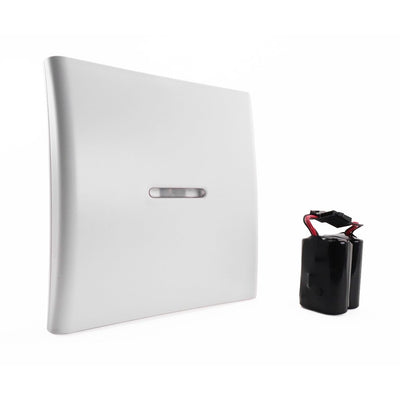
-
{"id":8700736837,"title":"DSC PG9901BATT Power G Wireless Indoor Siren With Battery","handle":"dsc-pg9901batt-power-g-wireless-indoor-siren-with-battery","description":"\u003cp class=\"product-excerpt\"\u003eThe PG9901 is an indoor PowerG wireless siren for the DSC NEO and Qolsys IQ Panels. With its sleek and subtle design, you won't have to worry about having a big speaker poking out of your wall. If you need an outdoor siren check out the \u003ca href=\"https:\/\/www.alarmsystemstore.com\/products\/dsc-pg9911b-batt-wireless-power-g-outdoor-siren-and-strobe\" title=\"DSC NEO PowerG PG9911 outdoor siren and strobe\"\u003ePG9911\u003c\/a\u003e.\u003c\/p\u003e\n\u003chr\u003e\n\u003ch2\u003eDSC PG9901BATT Power G Wireless Indoor Siren With Battery\u003c\/h2\u003e\n\u003cp\u003eThe DSC PG9901BATT is a combination of the PG9901 Indoor Siren and the long-life lithium battery that powers it. If you need a wireless indoor siren for any PowerG Series alarm system, like the DSC NEO, then the PG9901 would be the siren to purchase.\u003c\/p\u003e\n\u003cp\u003eThis siren blares at 85 dB. It operates on the 915 MHz wireless frequency and can pair with any PowerG Series alarm system. It features a built-in antenna and weighs 16.5 oz. It has a lightweight casing that measures \u003cspan\u003e6-7\/16 x 6-7\/16 x 1-3\/4 in and has an aesthetically pleasing design. \u003c\/span\u003e\u003cbr\u003e\u003cbr\u003e\u003c\/p\u003e\n\u003ch3\u003eSpecifications:\u003c\/h3\u003e\n\u003cp\u003eAlarm Sound Level: 85 dB at 3 m (10 feet)\u003cbr\u003eFrequency Band (MHz): CE Listed PG4901: 433MHz; CE\/EN listed PG8901: 868MHz; FCC\/IC\/UL\/ULC listed PG9901: 915MHz\u003cbr\u003eModulation GFSK\u003cbr\u003eAntenna: Built-in antenna\u003cbr\u003eCommunication Protocol: PowerG\u003cbr\u003eSiren Type: One Piezo 109 dB min. Sound Pressure Level @ 1m, 1400Hz-3200Hz, sweep frequency 7Hz\u003cbr\u003eBattery Type: \u003cspan data-mce-fragment=\"1\"\u003e3.6V, Li-Thionyl Chloride 0-102710\u003c\/span\u003e\u003cbr\u003eNote: Use only the above battery\u003cbr\u003eNote: The strobe flashes 5 times and the red LED lights continuously during first battery installation\u003cbr\u003eBattery Life Expectancy: 8 years (not verified by the UL\/ULC)\u003cbr\u003eLow Battery Threshold: 2V +300 mV negative slope OR 1.2V\u003cbr\u003eStobe Light: Pulsed @ 1 sec.\u003cbr\u003eTemperature range: -10C to +55C (UL\/ULC only verified the range 0-49C)\u003cbr\u003eRelative humidity: up to max. 93%RH, non-condensing (UL\/ULC only verified up to max 85%RH)\u003cbr\u003eDimensions (LxWxD): 161x161x50mm (6-7\/16 x 6-7\/16 x 1-3\/4 in)\u003cbr\u003eWeight 9including battery): 470g (16.5 oz)\u003cbr\u003eColor: white (with transparent lens)\u003c\/p\u003e\n\u003cp\u003e\u003ca title=\"DSC PG9901 Installation manual\" href=\"https:\/\/cdn.shopify.com\/s\/files\/1\/1659\/9809\/files\/PG9901-8901-4901_Installation_Manual_ENG-FRE-SPA-POR-29008698R001_1.pdf?4784474422414169140\" target=\"_blank\"\u003eDSC PG9901 Installation manual\u003cbr\u003e\u003c\/a\u003e\u003ca title=\"DSC PG9901 Specifications sheet\" href=\"https:\/\/cdn.shopify.com\/s\/files\/1\/1659\/9809\/files\/30001549R001_PG9901_Spec_Eng.pdf?4784474422414169140\" target=\"_blank\"\u003eDSC PG9901 Specifications sheet\u003c\/a\u003e\u003c\/p\u003e\n\u003cp\u003e\u003cstrong\u003e\u003cspan style=\"color: #ff0000;\"\u003eNOTE: This item cannot be shipped via air and as such cannot be\u003cbr\u003eshipped outside of the lower 48 USA. These also cannot be shipped via expedited shipping. (2nd Day, Overnight, etc.)\u003c\/span\u003e\u003c\/strong\u003e\u003c\/p\u003e\n\u003cp\u003e \u003c\/p\u003e\n\u003chr\u003e\n\u003cp\u003eVisible link quality indicator on the device\u003cbr\u003e110dB Siren with Strobe Light\u003cbr\u003eDifferentiated audible alerts for intrusion and fire\u003c\/p\u003e","published_at":"2018-06-07T11:05:36-04:00","created_at":"2017-08-02T12:10:50-04:00","vendor":"DSC","type":"DSC PowerSeries NEO Power G Wireless","tags":["DSC PowerSeries NEO","DSC PowerSeries NEO Power G Wireless","Els PW 22592"],"price":11299,"price_min":11299,"price_max":11299,"available":true,"price_varies":false,"compare_at_price":12899,"compare_at_price_min":12899,"compare_at_price_max":12899,"compare_at_price_varies":false,"variants":[{"id":38117377541,"title":"Default Title","option1":"Default Title","option2":null,"option3":null,"sku":"DSC-PG9901BATT","requires_shipping":true,"taxable":true,"featured_image":null,"available":true,"name":"DSC PG9901BATT Power G Wireless Indoor Siren With Battery","public_title":null,"options":["Default Title"],"price":11299,"weight":1361,"compare_at_price":12899,"inventory_quantity":2,"inventory_management":"shopify","inventory_policy":"continue","barcode":"DSC-PG9901BATT","requires_selling_plan":false,"selling_plan_allocations":[]}],"images":["\/\/www.alarmsystemstore.com\/cdn\/shop\/products\/dsc-pg9901batt-power-g-wireless-indoor-siren-with-battery-306584.jpg?v=1595526007","\/\/www.alarmsystemstore.com\/cdn\/shop\/products\/dsc-pg9901batt-power-g-wireless-indoor-siren-with-battery-360050.jpg?v=1595526007","\/\/www.alarmsystemstore.com\/cdn\/shop\/products\/dsc-pg9901batt-power-g-wireless-indoor-siren-with-battery-744844.jpg?v=1595526007","\/\/www.alarmsystemstore.com\/cdn\/shop\/products\/dsc-pg9901batt-power-g-wireless-indoor-siren-with-battery-988492.jpg?v=1595526007","\/\/www.alarmsystemstore.com\/cdn\/shop\/products\/dsc-pg9901batt-power-g-wireless-indoor-siren-with-battery-901109.jpg?v=1595526007"],"featured_image":"\/\/www.alarmsystemstore.com\/cdn\/shop\/products\/dsc-pg9901batt-power-g-wireless-indoor-siren-with-battery-306584.jpg?v=1595526007","options":["Title"],"media":[{"alt":"DSC PG9901BATT Power G Wireless Indoor Siren With Battery - AlarmSystemStore.com","id":7363082682470,"position":1,"preview_image":{"aspect_ratio":1.0,"height":1024,"width":1024,"src":"\/\/www.alarmsystemstore.com\/cdn\/shop\/products\/dsc-pg9901batt-power-g-wireless-indoor-siren-with-battery-306584.jpg?v=1595526007"},"aspect_ratio":1.0,"height":1024,"media_type":"image","src":"\/\/www.alarmsystemstore.com\/cdn\/shop\/products\/dsc-pg9901batt-power-g-wireless-indoor-siren-with-battery-306584.jpg?v=1595526007","width":1024},{"alt":"DSC PG9901BATT Power G Wireless Indoor Siren With Battery - AlarmSystemStore.com","id":7363082715238,"position":2,"preview_image":{"aspect_ratio":1.0,"height":1024,"width":1024,"src":"\/\/www.alarmsystemstore.com\/cdn\/shop\/products\/dsc-pg9901batt-power-g-wireless-indoor-siren-with-battery-360050.jpg?v=1595526007"},"aspect_ratio":1.0,"height":1024,"media_type":"image","src":"\/\/www.alarmsystemstore.com\/cdn\/shop\/products\/dsc-pg9901batt-power-g-wireless-indoor-siren-with-battery-360050.jpg?v=1595526007","width":1024},{"alt":"DSC PG9901BATT Power G Wireless Indoor Siren With Battery - AlarmSystemStore.com","id":7363082748006,"position":3,"preview_image":{"aspect_ratio":1.0,"height":1024,"width":1024,"src":"\/\/www.alarmsystemstore.com\/cdn\/shop\/products\/dsc-pg9901batt-power-g-wireless-indoor-siren-with-battery-744844.jpg?v=1595526007"},"aspect_ratio":1.0,"height":1024,"media_type":"image","src":"\/\/www.alarmsystemstore.com\/cdn\/shop\/products\/dsc-pg9901batt-power-g-wireless-indoor-siren-with-battery-744844.jpg?v=1595526007","width":1024},{"alt":"DSC PG9901BATT Power G Wireless Indoor Siren With Battery - AlarmSystemStore.com","id":7363082780774,"position":4,"preview_image":{"aspect_ratio":1.0,"height":1024,"width":1024,"src":"\/\/www.alarmsystemstore.com\/cdn\/shop\/products\/dsc-pg9901batt-power-g-wireless-indoor-siren-with-battery-988492.jpg?v=1595526007"},"aspect_ratio":1.0,"height":1024,"media_type":"image","src":"\/\/www.alarmsystemstore.com\/cdn\/shop\/products\/dsc-pg9901batt-power-g-wireless-indoor-siren-with-battery-988492.jpg?v=1595526007","width":1024},{"alt":"DSC PG9901BATT Power G Wireless Indoor Siren With Battery - AlarmSystemStore.com","id":7363082813542,"position":5,"preview_image":{"aspect_ratio":1.0,"height":1024,"width":1024,"src":"\/\/www.alarmsystemstore.com\/cdn\/shop\/products\/dsc-pg9901batt-power-g-wireless-indoor-siren-with-battery-901109.jpg?v=1595526007"},"aspect_ratio":1.0,"height":1024,"media_type":"image","src":"\/\/www.alarmsystemstore.com\/cdn\/shop\/products\/dsc-pg9901batt-power-g-wireless-indoor-siren-with-battery-901109.jpg?v=1595526007","width":1024}],"requires_selling_plan":false,"selling_plan_groups":[],"content":"\u003cp class=\"product-excerpt\"\u003eThe PG9901 is an indoor PowerG wireless siren for the DSC NEO and Qolsys IQ Panels. With its sleek and subtle design, you won't have to worry about having a big speaker poking out of your wall. If you need an outdoor siren check out the \u003ca href=\"https:\/\/www.alarmsystemstore.com\/products\/dsc-pg9911b-batt-wireless-power-g-outdoor-siren-and-strobe\" title=\"DSC NEO PowerG PG9911 outdoor siren and strobe\"\u003ePG9911\u003c\/a\u003e.\u003c\/p\u003e\n\u003chr\u003e\n\u003ch2\u003eDSC PG9901BATT Power G Wireless Indoor Siren With Battery\u003c\/h2\u003e\n\u003cp\u003eThe DSC PG9901BATT is a combination of the PG9901 Indoor Siren and the long-life lithium battery that powers it. If you need a wireless indoor siren for any PowerG Series alarm system, like the DSC NEO, then the PG9901 would be the siren to purchase.\u003c\/p\u003e\n\u003cp\u003eThis siren blares at 85 dB. It operates on the 915 MHz wireless frequency and can pair with any PowerG Series alarm system. It features a built-in antenna and weighs 16.5 oz. It has a lightweight casing that measures \u003cspan\u003e6-7\/16 x 6-7\/16 x 1-3\/4 in and has an aesthetically pleasing design. \u003c\/span\u003e\u003cbr\u003e\u003cbr\u003e\u003c\/p\u003e\n\u003ch3\u003eSpecifications:\u003c\/h3\u003e\n\u003cp\u003eAlarm Sound Level: 85 dB at 3 m (10 feet)\u003cbr\u003eFrequency Band (MHz): CE Listed PG4901: 433MHz; CE\/EN listed PG8901: 868MHz; FCC\/IC\/UL\/ULC listed PG9901: 915MHz\u003cbr\u003eModulation GFSK\u003cbr\u003eAntenna: Built-in antenna\u003cbr\u003eCommunication Protocol: PowerG\u003cbr\u003eSiren Type: One Piezo 109 dB min. Sound Pressure Level @ 1m, 1400Hz-3200Hz, sweep frequency 7Hz\u003cbr\u003eBattery Type: \u003cspan data-mce-fragment=\"1\"\u003e3.6V, Li-Thionyl Chloride 0-102710\u003c\/span\u003e\u003cbr\u003eNote: Use only the above battery\u003cbr\u003eNote: The strobe flashes 5 times and the red LED lights continuously during first battery installation\u003cbr\u003eBattery Life Expectancy: 8 years (not verified by the UL\/ULC)\u003cbr\u003eLow Battery Threshold: 2V +300 mV negative slope OR 1.2V\u003cbr\u003eStobe Light: Pulsed @ 1 sec.\u003cbr\u003eTemperature range: -10C to +55C (UL\/ULC only verified the range 0-49C)\u003cbr\u003eRelative humidity: up to max. 93%RH, non-condensing (UL\/ULC only verified up to max 85%RH)\u003cbr\u003eDimensions (LxWxD): 161x161x50mm (6-7\/16 x 6-7\/16 x 1-3\/4 in)\u003cbr\u003eWeight 9including battery): 470g (16.5 oz)\u003cbr\u003eColor: white (with transparent lens)\u003c\/p\u003e\n\u003cp\u003e\u003ca title=\"DSC PG9901 Installation manual\" href=\"https:\/\/cdn.shopify.com\/s\/files\/1\/1659\/9809\/files\/PG9901-8901-4901_Installation_Manual_ENG-FRE-SPA-POR-29008698R001_1.pdf?4784474422414169140\" target=\"_blank\"\u003eDSC PG9901 Installation manual\u003cbr\u003e\u003c\/a\u003e\u003ca title=\"DSC PG9901 Specifications sheet\" href=\"https:\/\/cdn.shopify.com\/s\/files\/1\/1659\/9809\/files\/30001549R001_PG9901_Spec_Eng.pdf?4784474422414169140\" target=\"_blank\"\u003eDSC PG9901 Specifications sheet\u003c\/a\u003e\u003c\/p\u003e\n\u003cp\u003e\u003cstrong\u003e\u003cspan style=\"color: #ff0000;\"\u003eNOTE: This item cannot be shipped via air and as such cannot be\u003cbr\u003eshipped outside of the lower 48 USA. These also cannot be shipped via expedited shipping. (2nd Day, Overnight, etc.)\u003c\/span\u003e\u003c\/strong\u003e\u003c\/p\u003e\n\u003cp\u003e \u003c\/p\u003e\n\u003chr\u003e\n\u003cp\u003eVisible link quality indicator on the device\u003cbr\u003e110dB Siren with Strobe Light\u003cbr\u003eDifferentiated audible alerts for intrusion and fire\u003c\/p\u003e"}
-
{"id":8700736837,"title":"DSC PG9901BATT Power G Wireless Indoor Siren With Battery","handle":"dsc-pg9901batt-power-g-wireless-indoor-siren-with-battery","description":"\u003cp class=\"product-excerpt\"\u003eThe PG9901 is an indoor PowerG wireless siren for the DSC NEO and Qolsys IQ Panels. With its sleek and subtle design, you won't have to worry about having a big speaker poking out of your wall. If you need an outdoor siren check out the \u003ca href=\"https:\/\/www.alarmsystemstore.com\/products\/dsc-pg9911b-batt-wireless-power-g-outdoor-siren-and-strobe\" title=\"DSC NEO PowerG PG9911 outdoor siren and strobe\"\u003ePG9911\u003c\/a\u003e.\u003c\/p\u003e\n\u003chr\u003e\n\u003ch2\u003eDSC PG9901BATT Power G Wireless Indoor Siren With Battery\u003c\/h2\u003e\n\u003cp\u003eThe DSC PG9901BATT is a combination of the PG9901 Indoor Siren and the long-life lithium battery that powers it. If you need a wireless indoor siren for any PowerG Series alarm system, like the DSC NEO, then the PG9901 would be the siren to purchase.\u003c\/p\u003e\n\u003cp\u003eThis siren blares at 85 dB. It operates on the 915 MHz wireless frequency and can pair with any PowerG Series alarm system. It features a built-in antenna and weighs 16.5 oz. It has a lightweight casing that measures \u003cspan\u003e6-7\/16 x 6-7\/16 x 1-3\/4 in and has an aesthetically pleasing design. \u003c\/span\u003e\u003cbr\u003e\u003cbr\u003e\u003c\/p\u003e\n\u003ch3\u003eSpecifications:\u003c\/h3\u003e\n\u003cp\u003eAlarm Sound Level: 85 dB at 3 m (10 feet)\u003cbr\u003eFrequency Band (MHz): CE Listed PG4901: 433MHz; CE\/EN listed PG8901: 868MHz; FCC\/IC\/UL\/ULC listed PG9901: 915MHz\u003cbr\u003eModulation GFSK\u003cbr\u003eAntenna: Built-in antenna\u003cbr\u003eCommunication Protocol: PowerG\u003cbr\u003eSiren Type: One Piezo 109 dB min. Sound Pressure Level @ 1m, 1400Hz-3200Hz, sweep frequency 7Hz\u003cbr\u003eBattery Type: \u003cspan data-mce-fragment=\"1\"\u003e3.6V, Li-Thionyl Chloride 0-102710\u003c\/span\u003e\u003cbr\u003eNote: Use only the above battery\u003cbr\u003eNote: The strobe flashes 5 times and the red LED lights continuously during first battery installation\u003cbr\u003eBattery Life Expectancy: 8 years (not verified by the UL\/ULC)\u003cbr\u003eLow Battery Threshold: 2V +300 mV negative slope OR 1.2V\u003cbr\u003eStobe Light: Pulsed @ 1 sec.\u003cbr\u003eTemperature range: -10C to +55C (UL\/ULC only verified the range 0-49C)\u003cbr\u003eRelative humidity: up to max. 93%RH, non-condensing (UL\/ULC only verified up to max 85%RH)\u003cbr\u003eDimensions (LxWxD): 161x161x50mm (6-7\/16 x 6-7\/16 x 1-3\/4 in)\u003cbr\u003eWeight 9including battery): 470g (16.5 oz)\u003cbr\u003eColor: white (with transparent lens)\u003c\/p\u003e\n\u003cp\u003e\u003ca title=\"DSC PG9901 Installation manual\" href=\"https:\/\/cdn.shopify.com\/s\/files\/1\/1659\/9809\/files\/PG9901-8901-4901_Installation_Manual_ENG-FRE-SPA-POR-29008698R001_1.pdf?4784474422414169140\" target=\"_blank\"\u003eDSC PG9901 Installation manual\u003cbr\u003e\u003c\/a\u003e\u003ca title=\"DSC PG9901 Specifications sheet\" href=\"https:\/\/cdn.shopify.com\/s\/files\/1\/1659\/9809\/files\/30001549R001_PG9901_Spec_Eng.pdf?4784474422414169140\" target=\"_blank\"\u003eDSC PG9901 Specifications sheet\u003c\/a\u003e\u003c\/p\u003e\n\u003cp\u003e\u003cstrong\u003e\u003cspan style=\"color: #ff0000;\"\u003eNOTE: This item cannot be shipped via air and as such cannot be\u003cbr\u003eshipped outside of the lower 48 USA. These also cannot be shipped via expedited shipping. (2nd Day, Overnight, etc.)\u003c\/span\u003e\u003c\/strong\u003e\u003c\/p\u003e\n\u003cp\u003e \u003c\/p\u003e\n\u003chr\u003e\n\u003cp\u003eVisible link quality indicator on the device\u003cbr\u003e110dB Siren with Strobe Light\u003cbr\u003eDifferentiated audible alerts for intrusion and fire\u003c\/p\u003e","published_at":"2018-06-07T11:05:36-04:00","created_at":"2017-08-02T12:10:50-04:00","vendor":"DSC","type":"DSC PowerSeries NEO Power G Wireless","tags":["DSC PowerSeries NEO","DSC PowerSeries NEO Power G Wireless","Els PW 22592"],"price":11299,"price_min":11299,"price_max":11299,"available":true,"price_varies":false,"compare_at_price":12899,"compare_at_price_min":12899,"compare_at_price_max":12899,"compare_at_price_varies":false,"variants":[{"id":38117377541,"title":"Default Title","option1":"Default Title","option2":null,"option3":null,"sku":"DSC-PG9901BATT","requires_shipping":true,"taxable":true,"featured_image":null,"available":true,"name":"DSC PG9901BATT Power G Wireless Indoor Siren With Battery","public_title":null,"options":["Default Title"],"price":11299,"weight":1361,"compare_at_price":12899,"inventory_quantity":2,"inventory_management":"shopify","inventory_policy":"continue","barcode":"DSC-PG9901BATT","requires_selling_plan":false,"selling_plan_allocations":[]}],"images":["\/\/www.alarmsystemstore.com\/cdn\/shop\/products\/dsc-pg9901batt-power-g-wireless-indoor-siren-with-battery-306584.jpg?v=1595526007","\/\/www.alarmsystemstore.com\/cdn\/shop\/products\/dsc-pg9901batt-power-g-wireless-indoor-siren-with-battery-360050.jpg?v=1595526007","\/\/www.alarmsystemstore.com\/cdn\/shop\/products\/dsc-pg9901batt-power-g-wireless-indoor-siren-with-battery-744844.jpg?v=1595526007","\/\/www.alarmsystemstore.com\/cdn\/shop\/products\/dsc-pg9901batt-power-g-wireless-indoor-siren-with-battery-988492.jpg?v=1595526007","\/\/www.alarmsystemstore.com\/cdn\/shop\/products\/dsc-pg9901batt-power-g-wireless-indoor-siren-with-battery-901109.jpg?v=1595526007"],"featured_image":"\/\/www.alarmsystemstore.com\/cdn\/shop\/products\/dsc-pg9901batt-power-g-wireless-indoor-siren-with-battery-306584.jpg?v=1595526007","options":["Title"],"media":[{"alt":"DSC PG9901BATT Power G Wireless Indoor Siren With Battery - AlarmSystemStore.com","id":7363082682470,"position":1,"preview_image":{"aspect_ratio":1.0,"height":1024,"width":1024,"src":"\/\/www.alarmsystemstore.com\/cdn\/shop\/products\/dsc-pg9901batt-power-g-wireless-indoor-siren-with-battery-306584.jpg?v=1595526007"},"aspect_ratio":1.0,"height":1024,"media_type":"image","src":"\/\/www.alarmsystemstore.com\/cdn\/shop\/products\/dsc-pg9901batt-power-g-wireless-indoor-siren-with-battery-306584.jpg?v=1595526007","width":1024},{"alt":"DSC PG9901BATT Power G Wireless Indoor Siren With Battery - AlarmSystemStore.com","id":7363082715238,"position":2,"preview_image":{"aspect_ratio":1.0,"height":1024,"width":1024,"src":"\/\/www.alarmsystemstore.com\/cdn\/shop\/products\/dsc-pg9901batt-power-g-wireless-indoor-siren-with-battery-360050.jpg?v=1595526007"},"aspect_ratio":1.0,"height":1024,"media_type":"image","src":"\/\/www.alarmsystemstore.com\/cdn\/shop\/products\/dsc-pg9901batt-power-g-wireless-indoor-siren-with-battery-360050.jpg?v=1595526007","width":1024},{"alt":"DSC PG9901BATT Power G Wireless Indoor Siren With Battery - AlarmSystemStore.com","id":7363082748006,"position":3,"preview_image":{"aspect_ratio":1.0,"height":1024,"width":1024,"src":"\/\/www.alarmsystemstore.com\/cdn\/shop\/products\/dsc-pg9901batt-power-g-wireless-indoor-siren-with-battery-744844.jpg?v=1595526007"},"aspect_ratio":1.0,"height":1024,"media_type":"image","src":"\/\/www.alarmsystemstore.com\/cdn\/shop\/products\/dsc-pg9901batt-power-g-wireless-indoor-siren-with-battery-744844.jpg?v=1595526007","width":1024},{"alt":"DSC PG9901BATT Power G Wireless Indoor Siren With Battery - AlarmSystemStore.com","id":7363082780774,"position":4,"preview_image":{"aspect_ratio":1.0,"height":1024,"width":1024,"src":"\/\/www.alarmsystemstore.com\/cdn\/shop\/products\/dsc-pg9901batt-power-g-wireless-indoor-siren-with-battery-988492.jpg?v=1595526007"},"aspect_ratio":1.0,"height":1024,"media_type":"image","src":"\/\/www.alarmsystemstore.com\/cdn\/shop\/products\/dsc-pg9901batt-power-g-wireless-indoor-siren-with-battery-988492.jpg?v=1595526007","width":1024},{"alt":"DSC PG9901BATT Power G Wireless Indoor Siren With Battery - AlarmSystemStore.com","id":7363082813542,"position":5,"preview_image":{"aspect_ratio":1.0,"height":1024,"width":1024,"src":"\/\/www.alarmsystemstore.com\/cdn\/shop\/products\/dsc-pg9901batt-power-g-wireless-indoor-siren-with-battery-901109.jpg?v=1595526007"},"aspect_ratio":1.0,"height":1024,"media_type":"image","src":"\/\/www.alarmsystemstore.com\/cdn\/shop\/products\/dsc-pg9901batt-power-g-wireless-indoor-siren-with-battery-901109.jpg?v=1595526007","width":1024}],"requires_selling_plan":false,"selling_plan_groups":[],"content":"\u003cp class=\"product-excerpt\"\u003eThe PG9901 is an indoor PowerG wireless siren for the DSC NEO and Qolsys IQ Panels. With its sleek and subtle design, you won't have to worry about having a big speaker poking out of your wall. If you need an outdoor siren check out the \u003ca href=\"https:\/\/www.alarmsystemstore.com\/products\/dsc-pg9911b-batt-wireless-power-g-outdoor-siren-and-strobe\" title=\"DSC NEO PowerG PG9911 outdoor siren and strobe\"\u003ePG9911\u003c\/a\u003e.\u003c\/p\u003e\n\u003chr\u003e\n\u003ch2\u003eDSC PG9901BATT Power G Wireless Indoor Siren With Battery\u003c\/h2\u003e\n\u003cp\u003eThe DSC PG9901BATT is a combination of the PG9901 Indoor Siren and the long-life lithium battery that powers it. If you need a wireless indoor siren for any PowerG Series alarm system, like the DSC NEO, then the PG9901 would be the siren to purchase.\u003c\/p\u003e\n\u003cp\u003eThis siren blares at 85 dB. It operates on the 915 MHz wireless frequency and can pair with any PowerG Series alarm system. It features a built-in antenna and weighs 16.5 oz. It has a lightweight casing that measures \u003cspan\u003e6-7\/16 x 6-7\/16 x 1-3\/4 in and has an aesthetically pleasing design. \u003c\/span\u003e\u003cbr\u003e\u003cbr\u003e\u003c\/p\u003e\n\u003ch3\u003eSpecifications:\u003c\/h3\u003e\n\u003cp\u003eAlarm Sound Level: 85 dB at 3 m (10 feet)\u003cbr\u003eFrequency Band (MHz): CE Listed PG4901: 433MHz; CE\/EN listed PG8901: 868MHz; FCC\/IC\/UL\/ULC listed PG9901: 915MHz\u003cbr\u003eModulation GFSK\u003cbr\u003eAntenna: Built-in antenna\u003cbr\u003eCommunication Protocol: PowerG\u003cbr\u003eSiren Type: One Piezo 109 dB min. Sound Pressure Level @ 1m, 1400Hz-3200Hz, sweep frequency 7Hz\u003cbr\u003eBattery Type: \u003cspan data-mce-fragment=\"1\"\u003e3.6V, Li-Thionyl Chloride 0-102710\u003c\/span\u003e\u003cbr\u003eNote: Use only the above battery\u003cbr\u003eNote: The strobe flashes 5 times and the red LED lights continuously during first battery installation\u003cbr\u003eBattery Life Expectancy: 8 years (not verified by the UL\/ULC)\u003cbr\u003eLow Battery Threshold: 2V +300 mV negative slope OR 1.2V\u003cbr\u003eStobe Light: Pulsed @ 1 sec.\u003cbr\u003eTemperature range: -10C to +55C (UL\/ULC only verified the range 0-49C)\u003cbr\u003eRelative humidity: up to max. 93%RH, non-condensing (UL\/ULC only verified up to max 85%RH)\u003cbr\u003eDimensions (LxWxD): 161x161x50mm (6-7\/16 x 6-7\/16 x 1-3\/4 in)\u003cbr\u003eWeight 9including battery): 470g (16.5 oz)\u003cbr\u003eColor: white (with transparent lens)\u003c\/p\u003e\n\u003cp\u003e\u003ca title=\"DSC PG9901 Installation manual\" href=\"https:\/\/cdn.shopify.com\/s\/files\/1\/1659\/9809\/files\/PG9901-8901-4901_Installation_Manual_ENG-FRE-SPA-POR-29008698R001_1.pdf?4784474422414169140\" target=\"_blank\"\u003eDSC PG9901 Installation manual\u003cbr\u003e\u003c\/a\u003e\u003ca title=\"DSC PG9901 Specifications sheet\" href=\"https:\/\/cdn.shopify.com\/s\/files\/1\/1659\/9809\/files\/30001549R001_PG9901_Spec_Eng.pdf?4784474422414169140\" target=\"_blank\"\u003eDSC PG9901 Specifications sheet\u003c\/a\u003e\u003c\/p\u003e\n\u003cp\u003e\u003cstrong\u003e\u003cspan style=\"color: #ff0000;\"\u003eNOTE: This item cannot be shipped via air and as such cannot be\u003cbr\u003eshipped outside of the lower 48 USA. These also cannot be shipped via expedited shipping. (2nd Day, Overnight, etc.)\u003c\/span\u003e\u003c\/strong\u003e\u003c\/p\u003e\n\u003cp\u003e \u003c\/p\u003e\n\u003chr\u003e\n\u003cp\u003eVisible link quality indicator on the device\u003cbr\u003e110dB Siren with Strobe Light\u003cbr\u003eDifferentiated audible alerts for intrusion and fire\u003c\/p\u003e"}
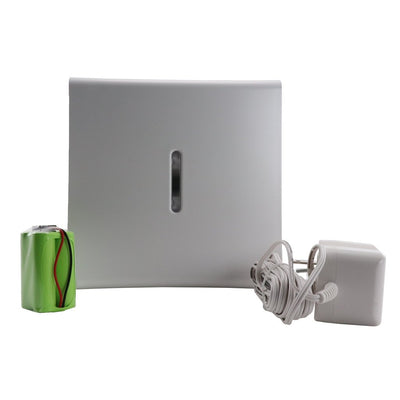
-
{"id":7037347333,"title":"DSC PowerSeries PG9920 PowerG 915Mhz Wireless Repeater.","handle":"dsc-powerseries-pg9920-powerg-915mhz-wireless-repeater","description":"\u003cp class=\"product-excerpt\"\u003eThe PG9920 is a wireless signal repeater designed to extend the range of your PowerG system. If you have trouble getting any devices to connect where they are located a repeater can be used to effectively double the range of the signal.\u003c\/p\u003e\n\u003chr\u003e\n\u003ch2\u003eDSC PowerSeries PG9920 PowerG 915Mhz Wireless Repeater\u003c\/h2\u003e\nThe Power G PG9920 is a wireless repeater that will extend the wireless range of your DSC NEO panel so that you can extend the reach of your wireless device installation. This will relay signals coming from devices that may be beyond the panel's original range. You can also use this as a signal booster for devices that are within the panel's usual range but are experiencing interference. You may use up to 8 of these per system.\u003cbr\u003e\u003cbr\u003eMessages from devices being carried by the PG9920 include:\u003cbr\u003e\u003cbr\u003e\n\u003cul\u003e\n\u003cli\u003eAC Fail\u003c\/li\u003e\n\u003cli\u003eLow Battery\u003c\/li\u003e\n\u003cli\u003eEnd Of Life\u003c\/li\u003e\n\u003cli\u003eTamper\u003c\/li\u003e\n\u003cli\u003eSupervision\u003c\/li\u003e\n\u003c\/ul\u003e\n\u003cbr\u003e\n\u003ch3\u003eSpecifications:\u003c\/h3\u003e\n\u003cp\u003eDimensions 161 x 161 x 50mm (6.44 x 6.44 x 1.75in)\u003cbr\u003eBattery Type 4.8V, 1300mAh Ni-MH rechargeable battery\u003cbr\u003eBattery Backup 48 hours\u003cbr\u003eWeight 470g (16.5oz)\u003cbr\u003eOperating Temperature -10°C to 55°C (14°F to 131°F)\u003cbr\u003e\u003cbr\u003e\u003c\/p\u003e\n\u003cp\u003e\u003ca href=\"https:\/\/cdn.shopify.com\/s\/files\/1\/1659\/9809\/files\/PG9920-8920-4920_Installation_Manual_ENG-FRE-SPA-POR-29008668R001.pdf?7048234221893183219\" title=\"DSC PG9920 Installation manual\" target=\"_blank\"\u003eDSC PG9920 Installation manual\u003cbr\u003e\u003c\/a\u003e\u003ca href=\"https:\/\/cdn.shopify.com\/s\/files\/1\/1659\/9809\/files\/PG9920_Spec-Sheet_ENG_R001_NA.pdf?7048234221893183219\" title=\"DSC PG9920 Specifications sheet\" target=\"_blank\"\u003eDSC PG9920 Specifications sheet\u003c\/a\u003e\u003c\/p\u003e\n\u003chr\u003eExtends the overall wireless range\u003cbr\u003eLED indications for power failure, activity, and installation performance diagnostics\u003cbr\u003eCompact and easy to install\u003cbr\u003eFront and back tamper protected","published_at":"2016-10-20T03:44:00-04:00","created_at":"2017-01-23T07:14:42-05:00","vendor":"DSC","type":"DSC PowerSeries NEO Power G Wireless","tags":["DSC PowerSeries NEO","DSC PowerSeries NEO Power G Wireless"],"price":13695,"price_min":13695,"price_max":13695,"available":true,"price_varies":false,"compare_at_price":16999,"compare_at_price_min":16999,"compare_at_price_max":16999,"compare_at_price_varies":false,"variants":[{"id":24526378565,"title":"Default Title","option1":"Default Title","option2":null,"option3":null,"sku":"DSC-PG9920","requires_shipping":true,"taxable":true,"featured_image":null,"available":true,"name":"DSC PowerSeries PG9920 PowerG 915Mhz Wireless Repeater.","public_title":null,"options":["Default Title"],"price":13695,"weight":1361,"compare_at_price":16999,"inventory_quantity":1,"inventory_management":"shopify","inventory_policy":"continue","barcode":"DSC-PG9920","requires_selling_plan":false,"selling_plan_allocations":[]}],"images":["\/\/www.alarmsystemstore.com\/cdn\/shop\/products\/dsc-powerseries-pg9920-powerg-915mhz-wireless-repeater-773420.jpg?v=1595526007","\/\/www.alarmsystemstore.com\/cdn\/shop\/products\/dsc-powerseries-pg9920-powerg-915mhz-wireless-repeater-483969.jpg?v=1595526007","\/\/www.alarmsystemstore.com\/cdn\/shop\/products\/dsc-powerseries-pg9920-powerg-915mhz-wireless-repeater-888658.jpg?v=1595526007","\/\/www.alarmsystemstore.com\/cdn\/shop\/products\/dsc-powerseries-pg9920-powerg-915mhz-wireless-repeater-328918.jpg?v=1595526007","\/\/www.alarmsystemstore.com\/cdn\/shop\/products\/dsc-powerseries-pg9920-powerg-915mhz-wireless-repeater-109805.jpg?v=1595526007"],"featured_image":"\/\/www.alarmsystemstore.com\/cdn\/shop\/products\/dsc-powerseries-pg9920-powerg-915mhz-wireless-repeater-773420.jpg?v=1595526007","options":["Title"],"media":[{"alt":"DSC PowerSeries PG9920 PowerG 915Mhz Wireless Repeater. - AlarmSystemStore.com","id":7363082453094,"position":1,"preview_image":{"aspect_ratio":1.0,"height":1024,"width":1024,"src":"\/\/www.alarmsystemstore.com\/cdn\/shop\/products\/dsc-powerseries-pg9920-powerg-915mhz-wireless-repeater-773420.jpg?v=1595526007"},"aspect_ratio":1.0,"height":1024,"media_type":"image","src":"\/\/www.alarmsystemstore.com\/cdn\/shop\/products\/dsc-powerseries-pg9920-powerg-915mhz-wireless-repeater-773420.jpg?v=1595526007","width":1024},{"alt":"DSC PowerSeries PG9920 PowerG 915Mhz Wireless Repeater. - AlarmSystemStore.com","id":7363082485862,"position":2,"preview_image":{"aspect_ratio":1.0,"height":1024,"width":1024,"src":"\/\/www.alarmsystemstore.com\/cdn\/shop\/products\/dsc-powerseries-pg9920-powerg-915mhz-wireless-repeater-483969.jpg?v=1595526007"},"aspect_ratio":1.0,"height":1024,"media_type":"image","src":"\/\/www.alarmsystemstore.com\/cdn\/shop\/products\/dsc-powerseries-pg9920-powerg-915mhz-wireless-repeater-483969.jpg?v=1595526007","width":1024},{"alt":"DSC PowerSeries PG9920 PowerG 915Mhz Wireless Repeater. - AlarmSystemStore.com","id":7363082518630,"position":3,"preview_image":{"aspect_ratio":1.0,"height":1024,"width":1024,"src":"\/\/www.alarmsystemstore.com\/cdn\/shop\/products\/dsc-powerseries-pg9920-powerg-915mhz-wireless-repeater-888658.jpg?v=1595526007"},"aspect_ratio":1.0,"height":1024,"media_type":"image","src":"\/\/www.alarmsystemstore.com\/cdn\/shop\/products\/dsc-powerseries-pg9920-powerg-915mhz-wireless-repeater-888658.jpg?v=1595526007","width":1024},{"alt":"DSC PowerSeries PG9920 PowerG 915Mhz Wireless Repeater. - AlarmSystemStore.com","id":7363082551398,"position":4,"preview_image":{"aspect_ratio":1.0,"height":1024,"width":1024,"src":"\/\/www.alarmsystemstore.com\/cdn\/shop\/products\/dsc-powerseries-pg9920-powerg-915mhz-wireless-repeater-328918.jpg?v=1595526007"},"aspect_ratio":1.0,"height":1024,"media_type":"image","src":"\/\/www.alarmsystemstore.com\/cdn\/shop\/products\/dsc-powerseries-pg9920-powerg-915mhz-wireless-repeater-328918.jpg?v=1595526007","width":1024},{"alt":"DSC PowerSeries PG9920 PowerG 915Mhz Wireless Repeater. - AlarmSystemStore.com","id":7363082584166,"position":5,"preview_image":{"aspect_ratio":1.0,"height":1024,"width":1024,"src":"\/\/www.alarmsystemstore.com\/cdn\/shop\/products\/dsc-powerseries-pg9920-powerg-915mhz-wireless-repeater-109805.jpg?v=1595526007"},"aspect_ratio":1.0,"height":1024,"media_type":"image","src":"\/\/www.alarmsystemstore.com\/cdn\/shop\/products\/dsc-powerseries-pg9920-powerg-915mhz-wireless-repeater-109805.jpg?v=1595526007","width":1024}],"requires_selling_plan":false,"selling_plan_groups":[],"content":"\u003cp class=\"product-excerpt\"\u003eThe PG9920 is a wireless signal repeater designed to extend the range of your PowerG system. If you have trouble getting any devices to connect where they are located a repeater can be used to effectively double the range of the signal.\u003c\/p\u003e\n\u003chr\u003e\n\u003ch2\u003eDSC PowerSeries PG9920 PowerG 915Mhz Wireless Repeater\u003c\/h2\u003e\nThe Power G PG9920 is a wireless repeater that will extend the wireless range of your DSC NEO panel so that you can extend the reach of your wireless device installation. This will relay signals coming from devices that may be beyond the panel's original range. You can also use this as a signal booster for devices that are within the panel's usual range but are experiencing interference. You may use up to 8 of these per system.\u003cbr\u003e\u003cbr\u003eMessages from devices being carried by the PG9920 include:\u003cbr\u003e\u003cbr\u003e\n\u003cul\u003e\n\u003cli\u003eAC Fail\u003c\/li\u003e\n\u003cli\u003eLow Battery\u003c\/li\u003e\n\u003cli\u003eEnd Of Life\u003c\/li\u003e\n\u003cli\u003eTamper\u003c\/li\u003e\n\u003cli\u003eSupervision\u003c\/li\u003e\n\u003c\/ul\u003e\n\u003cbr\u003e\n\u003ch3\u003eSpecifications:\u003c\/h3\u003e\n\u003cp\u003eDimensions 161 x 161 x 50mm (6.44 x 6.44 x 1.75in)\u003cbr\u003eBattery Type 4.8V, 1300mAh Ni-MH rechargeable battery\u003cbr\u003eBattery Backup 48 hours\u003cbr\u003eWeight 470g (16.5oz)\u003cbr\u003eOperating Temperature -10°C to 55°C (14°F to 131°F)\u003cbr\u003e\u003cbr\u003e\u003c\/p\u003e\n\u003cp\u003e\u003ca href=\"https:\/\/cdn.shopify.com\/s\/files\/1\/1659\/9809\/files\/PG9920-8920-4920_Installation_Manual_ENG-FRE-SPA-POR-29008668R001.pdf?7048234221893183219\" title=\"DSC PG9920 Installation manual\" target=\"_blank\"\u003eDSC PG9920 Installation manual\u003cbr\u003e\u003c\/a\u003e\u003ca href=\"https:\/\/cdn.shopify.com\/s\/files\/1\/1659\/9809\/files\/PG9920_Spec-Sheet_ENG_R001_NA.pdf?7048234221893183219\" title=\"DSC PG9920 Specifications sheet\" target=\"_blank\"\u003eDSC PG9920 Specifications sheet\u003c\/a\u003e\u003c\/p\u003e\n\u003chr\u003eExtends the overall wireless range\u003cbr\u003eLED indications for power failure, activity, and installation performance diagnostics\u003cbr\u003eCompact and easy to install\u003cbr\u003eFront and back tamper protected"}
-
{"id":7037347333,"title":"DSC PowerSeries PG9920 PowerG 915Mhz Wireless Repeater.","handle":"dsc-powerseries-pg9920-powerg-915mhz-wireless-repeater","description":"\u003cp class=\"product-excerpt\"\u003eThe PG9920 is a wireless signal repeater designed to extend the range of your PowerG system. If you have trouble getting any devices to connect where they are located a repeater can be used to effectively double the range of the signal.\u003c\/p\u003e\n\u003chr\u003e\n\u003ch2\u003eDSC PowerSeries PG9920 PowerG 915Mhz Wireless Repeater\u003c\/h2\u003e\nThe Power G PG9920 is a wireless repeater that will extend the wireless range of your DSC NEO panel so that you can extend the reach of your wireless device installation. This will relay signals coming from devices that may be beyond the panel's original range. You can also use this as a signal booster for devices that are within the panel's usual range but are experiencing interference. You may use up to 8 of these per system.\u003cbr\u003e\u003cbr\u003eMessages from devices being carried by the PG9920 include:\u003cbr\u003e\u003cbr\u003e\n\u003cul\u003e\n\u003cli\u003eAC Fail\u003c\/li\u003e\n\u003cli\u003eLow Battery\u003c\/li\u003e\n\u003cli\u003eEnd Of Life\u003c\/li\u003e\n\u003cli\u003eTamper\u003c\/li\u003e\n\u003cli\u003eSupervision\u003c\/li\u003e\n\u003c\/ul\u003e\n\u003cbr\u003e\n\u003ch3\u003eSpecifications:\u003c\/h3\u003e\n\u003cp\u003eDimensions 161 x 161 x 50mm (6.44 x 6.44 x 1.75in)\u003cbr\u003eBattery Type 4.8V, 1300mAh Ni-MH rechargeable battery\u003cbr\u003eBattery Backup 48 hours\u003cbr\u003eWeight 470g (16.5oz)\u003cbr\u003eOperating Temperature -10°C to 55°C (14°F to 131°F)\u003cbr\u003e\u003cbr\u003e\u003c\/p\u003e\n\u003cp\u003e\u003ca href=\"https:\/\/cdn.shopify.com\/s\/files\/1\/1659\/9809\/files\/PG9920-8920-4920_Installation_Manual_ENG-FRE-SPA-POR-29008668R001.pdf?7048234221893183219\" title=\"DSC PG9920 Installation manual\" target=\"_blank\"\u003eDSC PG9920 Installation manual\u003cbr\u003e\u003c\/a\u003e\u003ca href=\"https:\/\/cdn.shopify.com\/s\/files\/1\/1659\/9809\/files\/PG9920_Spec-Sheet_ENG_R001_NA.pdf?7048234221893183219\" title=\"DSC PG9920 Specifications sheet\" target=\"_blank\"\u003eDSC PG9920 Specifications sheet\u003c\/a\u003e\u003c\/p\u003e\n\u003chr\u003eExtends the overall wireless range\u003cbr\u003eLED indications for power failure, activity, and installation performance diagnostics\u003cbr\u003eCompact and easy to install\u003cbr\u003eFront and back tamper protected","published_at":"2016-10-20T03:44:00-04:00","created_at":"2017-01-23T07:14:42-05:00","vendor":"DSC","type":"DSC PowerSeries NEO Power G Wireless","tags":["DSC PowerSeries NEO","DSC PowerSeries NEO Power G Wireless"],"price":13695,"price_min":13695,"price_max":13695,"available":true,"price_varies":false,"compare_at_price":16999,"compare_at_price_min":16999,"compare_at_price_max":16999,"compare_at_price_varies":false,"variants":[{"id":24526378565,"title":"Default Title","option1":"Default Title","option2":null,"option3":null,"sku":"DSC-PG9920","requires_shipping":true,"taxable":true,"featured_image":null,"available":true,"name":"DSC PowerSeries PG9920 PowerG 915Mhz Wireless Repeater.","public_title":null,"options":["Default Title"],"price":13695,"weight":1361,"compare_at_price":16999,"inventory_quantity":1,"inventory_management":"shopify","inventory_policy":"continue","barcode":"DSC-PG9920","requires_selling_plan":false,"selling_plan_allocations":[]}],"images":["\/\/www.alarmsystemstore.com\/cdn\/shop\/products\/dsc-powerseries-pg9920-powerg-915mhz-wireless-repeater-773420.jpg?v=1595526007","\/\/www.alarmsystemstore.com\/cdn\/shop\/products\/dsc-powerseries-pg9920-powerg-915mhz-wireless-repeater-483969.jpg?v=1595526007","\/\/www.alarmsystemstore.com\/cdn\/shop\/products\/dsc-powerseries-pg9920-powerg-915mhz-wireless-repeater-888658.jpg?v=1595526007","\/\/www.alarmsystemstore.com\/cdn\/shop\/products\/dsc-powerseries-pg9920-powerg-915mhz-wireless-repeater-328918.jpg?v=1595526007","\/\/www.alarmsystemstore.com\/cdn\/shop\/products\/dsc-powerseries-pg9920-powerg-915mhz-wireless-repeater-109805.jpg?v=1595526007"],"featured_image":"\/\/www.alarmsystemstore.com\/cdn\/shop\/products\/dsc-powerseries-pg9920-powerg-915mhz-wireless-repeater-773420.jpg?v=1595526007","options":["Title"],"media":[{"alt":"DSC PowerSeries PG9920 PowerG 915Mhz Wireless Repeater. - AlarmSystemStore.com","id":7363082453094,"position":1,"preview_image":{"aspect_ratio":1.0,"height":1024,"width":1024,"src":"\/\/www.alarmsystemstore.com\/cdn\/shop\/products\/dsc-powerseries-pg9920-powerg-915mhz-wireless-repeater-773420.jpg?v=1595526007"},"aspect_ratio":1.0,"height":1024,"media_type":"image","src":"\/\/www.alarmsystemstore.com\/cdn\/shop\/products\/dsc-powerseries-pg9920-powerg-915mhz-wireless-repeater-773420.jpg?v=1595526007","width":1024},{"alt":"DSC PowerSeries PG9920 PowerG 915Mhz Wireless Repeater. - AlarmSystemStore.com","id":7363082485862,"position":2,"preview_image":{"aspect_ratio":1.0,"height":1024,"width":1024,"src":"\/\/www.alarmsystemstore.com\/cdn\/shop\/products\/dsc-powerseries-pg9920-powerg-915mhz-wireless-repeater-483969.jpg?v=1595526007"},"aspect_ratio":1.0,"height":1024,"media_type":"image","src":"\/\/www.alarmsystemstore.com\/cdn\/shop\/products\/dsc-powerseries-pg9920-powerg-915mhz-wireless-repeater-483969.jpg?v=1595526007","width":1024},{"alt":"DSC PowerSeries PG9920 PowerG 915Mhz Wireless Repeater. - AlarmSystemStore.com","id":7363082518630,"position":3,"preview_image":{"aspect_ratio":1.0,"height":1024,"width":1024,"src":"\/\/www.alarmsystemstore.com\/cdn\/shop\/products\/dsc-powerseries-pg9920-powerg-915mhz-wireless-repeater-888658.jpg?v=1595526007"},"aspect_ratio":1.0,"height":1024,"media_type":"image","src":"\/\/www.alarmsystemstore.com\/cdn\/shop\/products\/dsc-powerseries-pg9920-powerg-915mhz-wireless-repeater-888658.jpg?v=1595526007","width":1024},{"alt":"DSC PowerSeries PG9920 PowerG 915Mhz Wireless Repeater. - AlarmSystemStore.com","id":7363082551398,"position":4,"preview_image":{"aspect_ratio":1.0,"height":1024,"width":1024,"src":"\/\/www.alarmsystemstore.com\/cdn\/shop\/products\/dsc-powerseries-pg9920-powerg-915mhz-wireless-repeater-328918.jpg?v=1595526007"},"aspect_ratio":1.0,"height":1024,"media_type":"image","src":"\/\/www.alarmsystemstore.com\/cdn\/shop\/products\/dsc-powerseries-pg9920-powerg-915mhz-wireless-repeater-328918.jpg?v=1595526007","width":1024},{"alt":"DSC PowerSeries PG9920 PowerG 915Mhz Wireless Repeater. - AlarmSystemStore.com","id":7363082584166,"position":5,"preview_image":{"aspect_ratio":1.0,"height":1024,"width":1024,"src":"\/\/www.alarmsystemstore.com\/cdn\/shop\/products\/dsc-powerseries-pg9920-powerg-915mhz-wireless-repeater-109805.jpg?v=1595526007"},"aspect_ratio":1.0,"height":1024,"media_type":"image","src":"\/\/www.alarmsystemstore.com\/cdn\/shop\/products\/dsc-powerseries-pg9920-powerg-915mhz-wireless-repeater-109805.jpg?v=1595526007","width":1024}],"requires_selling_plan":false,"selling_plan_groups":[],"content":"\u003cp class=\"product-excerpt\"\u003eThe PG9920 is a wireless signal repeater designed to extend the range of your PowerG system. If you have trouble getting any devices to connect where they are located a repeater can be used to effectively double the range of the signal.\u003c\/p\u003e\n\u003chr\u003e\n\u003ch2\u003eDSC PowerSeries PG9920 PowerG 915Mhz Wireless Repeater\u003c\/h2\u003e\nThe Power G PG9920 is a wireless repeater that will extend the wireless range of your DSC NEO panel so that you can extend the reach of your wireless device installation. This will relay signals coming from devices that may be beyond the panel's original range. You can also use this as a signal booster for devices that are within the panel's usual range but are experiencing interference. You may use up to 8 of these per system.\u003cbr\u003e\u003cbr\u003eMessages from devices being carried by the PG9920 include:\u003cbr\u003e\u003cbr\u003e\n\u003cul\u003e\n\u003cli\u003eAC Fail\u003c\/li\u003e\n\u003cli\u003eLow Battery\u003c\/li\u003e\n\u003cli\u003eEnd Of Life\u003c\/li\u003e\n\u003cli\u003eTamper\u003c\/li\u003e\n\u003cli\u003eSupervision\u003c\/li\u003e\n\u003c\/ul\u003e\n\u003cbr\u003e\n\u003ch3\u003eSpecifications:\u003c\/h3\u003e\n\u003cp\u003eDimensions 161 x 161 x 50mm (6.44 x 6.44 x 1.75in)\u003cbr\u003eBattery Type 4.8V, 1300mAh Ni-MH rechargeable battery\u003cbr\u003eBattery Backup 48 hours\u003cbr\u003eWeight 470g (16.5oz)\u003cbr\u003eOperating Temperature -10°C to 55°C (14°F to 131°F)\u003cbr\u003e\u003cbr\u003e\u003c\/p\u003e\n\u003cp\u003e\u003ca href=\"https:\/\/cdn.shopify.com\/s\/files\/1\/1659\/9809\/files\/PG9920-8920-4920_Installation_Manual_ENG-FRE-SPA-POR-29008668R001.pdf?7048234221893183219\" title=\"DSC PG9920 Installation manual\" target=\"_blank\"\u003eDSC PG9920 Installation manual\u003cbr\u003e\u003c\/a\u003e\u003ca href=\"https:\/\/cdn.shopify.com\/s\/files\/1\/1659\/9809\/files\/PG9920_Spec-Sheet_ENG_R001_NA.pdf?7048234221893183219\" title=\"DSC PG9920 Specifications sheet\" target=\"_blank\"\u003eDSC PG9920 Specifications sheet\u003c\/a\u003e\u003c\/p\u003e\n\u003chr\u003eExtends the overall wireless range\u003cbr\u003eLED indications for power failure, activity, and installation performance diagnostics\u003cbr\u003eCompact and easy to install\u003cbr\u003eFront and back tamper protected"}
